Projects Negotiation and Conflict Report: QH Payroll Project Analysis
VerifiedAdded on 2023/06/08
|8
|2867
|251
Report
AI Summary
This report, titled "Projects Negotiation and Conflict Report," analyzes the Queensland Health (QH) payroll project, a significant IT project failure in the Southern Hemisphere. It examines the project's background, including program information, stakeholders (QH, IBM, CorpTech), and the roles of various committees and groups. The report details four key projects based on KPMG's recommendations: forward strategy for the payroll system, governance and decision-making, people and change, and funding. For each project, it identifies participants (owners, designers, contractors), their negotiating positions, and potential conflicts. The report then suggests negotiation strategies and methods for each project, including strategic, concession exchange, behavioral, and structural approaches. The analysis draws upon various project management and negotiation theories to provide a comprehensive understanding of the project's challenges and potential solutions. The report aims to serve as a communication tool for managing negotiation, identifying conflict areas, and stakeholder engagement within the context of this complex project.
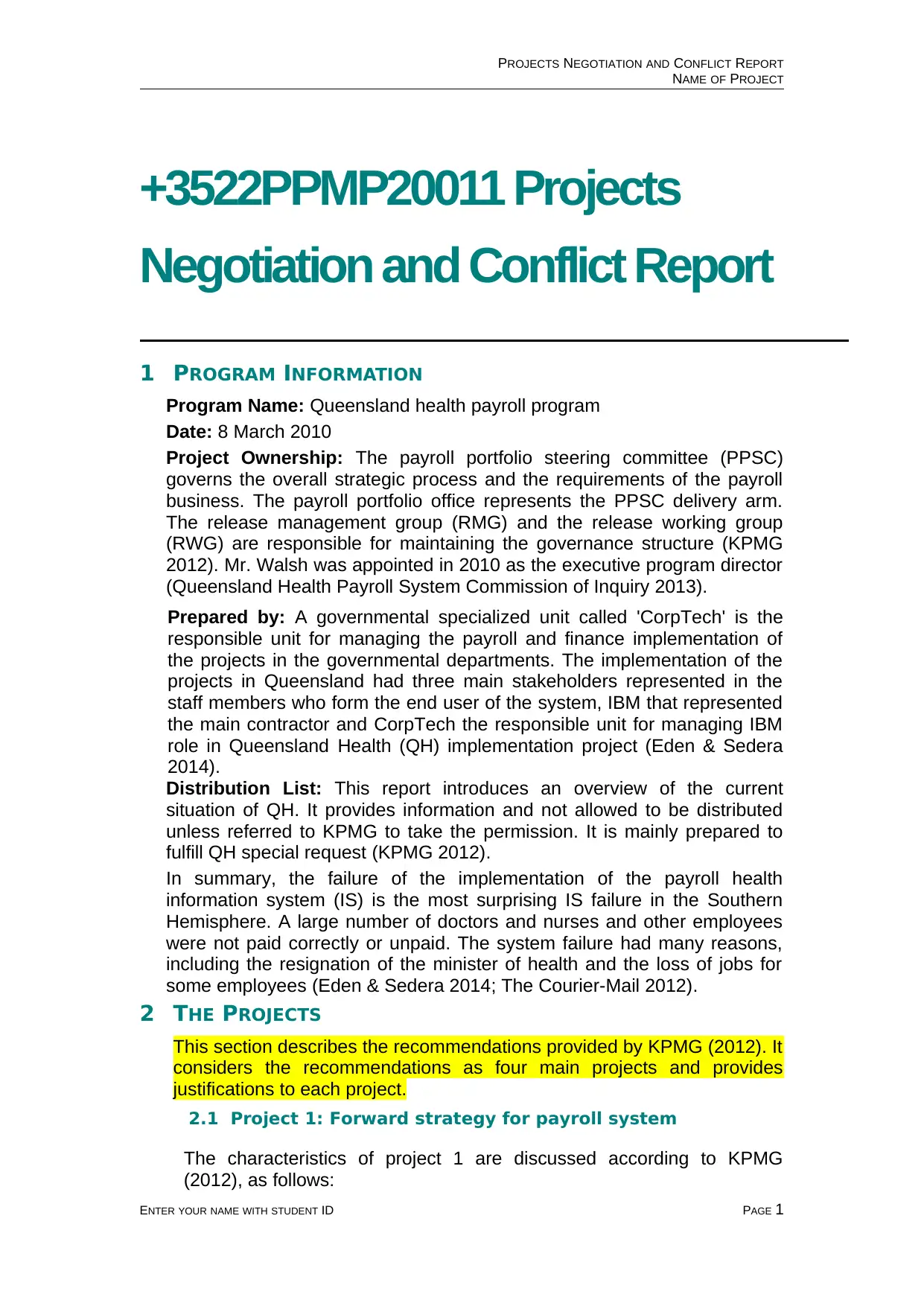
PROJECTS NEGOTIATION AND CONFLICT REPORT
NAME OF PROJECT
+3522PPMP20011 Projects
Negotiation and Conflict Report
1 PROGRAM INFORMATION
Program Name: Queensland health payroll program
Date: 8 March 2010
Project Ownership: The payroll portfolio steering committee (PPSC)
governs the overall strategic process and the requirements of the payroll
business. The payroll portfolio office represents the PPSC delivery arm.
The release management group (RMG) and the release working group
(RWG) are responsible for maintaining the governance structure (KPMG
2012). Mr. Walsh was appointed in 2010 as the executive program director
(Queensland Health Payroll System Commission of Inquiry 2013).
Prepared by: A governmental specialized unit called 'CorpTech' is the
responsible unit for managing the payroll and finance implementation of
the projects in the governmental departments. The implementation of the
projects in Queensland had three main stakeholders represented in the
staff members who form the end user of the system, IBM that represented
the main contractor and CorpTech the responsible unit for managing IBM
role in Queensland Health (QH) implementation project (Eden & Sedera
2014).
Distribution List: This report introduces an overview of the current
situation of QH. It provides information and not allowed to be distributed
unless referred to KPMG to take the permission. It is mainly prepared to
fulfill QH special request (KPMG 2012).
In summary, the failure of the implementation of the payroll health
information system (IS) is the most surprising IS failure in the Southern
Hemisphere. A large number of doctors and nurses and other employees
were not paid correctly or unpaid. The system failure had many reasons,
including the resignation of the minister of health and the loss of jobs for
some employees (Eden & Sedera 2014; The Courier-Mail 2012).
2 THE PROJECTS
This section describes the recommendations provided by KPMG (2012). It
considers the recommendations as four main projects and provides
justifications to each project.
2.1 Project 1: Forward strategy for payroll system
The characteristics of project 1 are discussed according to KPMG
(2012), as follows:
ENTER YOUR NAME WITH STUDENT ID PAGE 1
NAME OF PROJECT
+3522PPMP20011 Projects
Negotiation and Conflict Report
1 PROGRAM INFORMATION
Program Name: Queensland health payroll program
Date: 8 March 2010
Project Ownership: The payroll portfolio steering committee (PPSC)
governs the overall strategic process and the requirements of the payroll
business. The payroll portfolio office represents the PPSC delivery arm.
The release management group (RMG) and the release working group
(RWG) are responsible for maintaining the governance structure (KPMG
2012). Mr. Walsh was appointed in 2010 as the executive program director
(Queensland Health Payroll System Commission of Inquiry 2013).
Prepared by: A governmental specialized unit called 'CorpTech' is the
responsible unit for managing the payroll and finance implementation of
the projects in the governmental departments. The implementation of the
projects in Queensland had three main stakeholders represented in the
staff members who form the end user of the system, IBM that represented
the main contractor and CorpTech the responsible unit for managing IBM
role in Queensland Health (QH) implementation project (Eden & Sedera
2014).
Distribution List: This report introduces an overview of the current
situation of QH. It provides information and not allowed to be distributed
unless referred to KPMG to take the permission. It is mainly prepared to
fulfill QH special request (KPMG 2012).
In summary, the failure of the implementation of the payroll health
information system (IS) is the most surprising IS failure in the Southern
Hemisphere. A large number of doctors and nurses and other employees
were not paid correctly or unpaid. The system failure had many reasons,
including the resignation of the minister of health and the loss of jobs for
some employees (Eden & Sedera 2014; The Courier-Mail 2012).
2 THE PROJECTS
This section describes the recommendations provided by KPMG (2012). It
considers the recommendations as four main projects and provides
justifications to each project.
2.1 Project 1: Forward strategy for payroll system
The characteristics of project 1 are discussed according to KPMG
(2012), as follows:
ENTER YOUR NAME WITH STUDENT ID PAGE 1
Paraphrase This Document
Need a fresh take? Get an instant paraphrase of this document with our AI Paraphraser
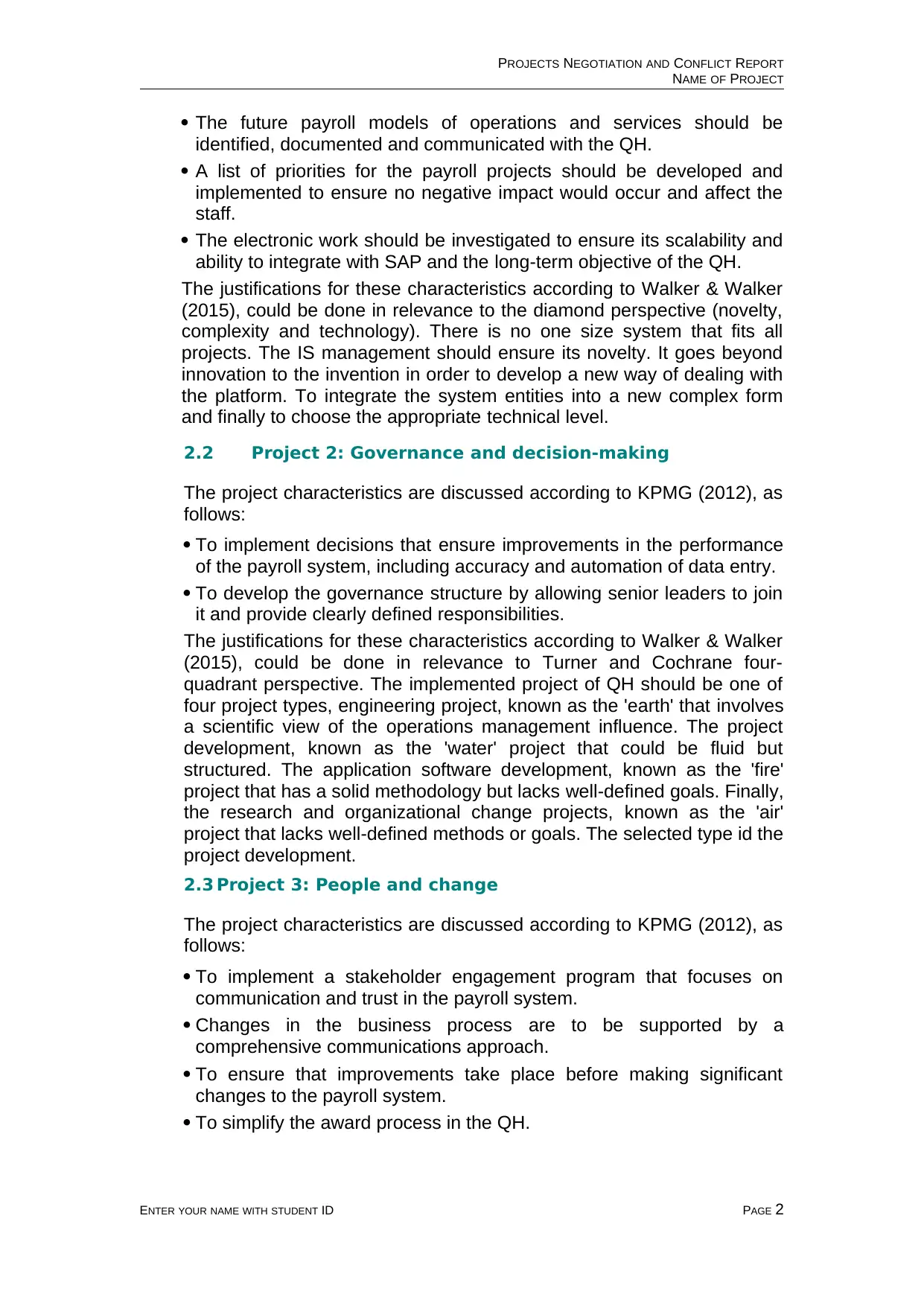
PROJECTS NEGOTIATION AND CONFLICT REPORT
NAME OF PROJECT
The future payroll models of operations and services should be
identified, documented and communicated with the QH.
A list of priorities for the payroll projects should be developed and
implemented to ensure no negative impact would occur and affect the
staff.
The electronic work should be investigated to ensure its scalability and
ability to integrate with SAP and the long-term objective of the QH.
The justifications for these characteristics according to Walker & Walker
(2015), could be done in relevance to the diamond perspective (novelty,
complexity and technology). There is no one size system that fits all
projects. The IS management should ensure its novelty. It goes beyond
innovation to the invention in order to develop a new way of dealing with
the platform. To integrate the system entities into a new complex form
and finally to choose the appropriate technical level.
2.2 Project 2: Governance and decision-making
The project characteristics are discussed according to KPMG (2012), as
follows:
To implement decisions that ensure improvements in the performance
of the payroll system, including accuracy and automation of data entry.
To develop the governance structure by allowing senior leaders to join
it and provide clearly defined responsibilities.
The justifications for these characteristics according to Walker & Walker
(2015), could be done in relevance to Turner and Cochrane four-
quadrant perspective. The implemented project of QH should be one of
four project types, engineering project, known as the 'earth' that involves
a scientific view of the operations management influence. The project
development, known as the 'water' project that could be fluid but
structured. The application software development, known as the 'fire'
project that has a solid methodology but lacks well-defined goals. Finally,
the research and organizational change projects, known as the 'air'
project that lacks well-defined methods or goals. The selected type id the
project development.
2.3 Project 3: People and change
The project characteristics are discussed according to KPMG (2012), as
follows:
To implement a stakeholder engagement program that focuses on
communication and trust in the payroll system.
Changes in the business process are to be supported by a
comprehensive communications approach.
To ensure that improvements take place before making significant
changes to the payroll system.
To simplify the award process in the QH.
ENTER YOUR NAME WITH STUDENT ID PAGE 2
NAME OF PROJECT
The future payroll models of operations and services should be
identified, documented and communicated with the QH.
A list of priorities for the payroll projects should be developed and
implemented to ensure no negative impact would occur and affect the
staff.
The electronic work should be investigated to ensure its scalability and
ability to integrate with SAP and the long-term objective of the QH.
The justifications for these characteristics according to Walker & Walker
(2015), could be done in relevance to the diamond perspective (novelty,
complexity and technology). There is no one size system that fits all
projects. The IS management should ensure its novelty. It goes beyond
innovation to the invention in order to develop a new way of dealing with
the platform. To integrate the system entities into a new complex form
and finally to choose the appropriate technical level.
2.2 Project 2: Governance and decision-making
The project characteristics are discussed according to KPMG (2012), as
follows:
To implement decisions that ensure improvements in the performance
of the payroll system, including accuracy and automation of data entry.
To develop the governance structure by allowing senior leaders to join
it and provide clearly defined responsibilities.
The justifications for these characteristics according to Walker & Walker
(2015), could be done in relevance to Turner and Cochrane four-
quadrant perspective. The implemented project of QH should be one of
four project types, engineering project, known as the 'earth' that involves
a scientific view of the operations management influence. The project
development, known as the 'water' project that could be fluid but
structured. The application software development, known as the 'fire'
project that has a solid methodology but lacks well-defined goals. Finally,
the research and organizational change projects, known as the 'air'
project that lacks well-defined methods or goals. The selected type id the
project development.
2.3 Project 3: People and change
The project characteristics are discussed according to KPMG (2012), as
follows:
To implement a stakeholder engagement program that focuses on
communication and trust in the payroll system.
Changes in the business process are to be supported by a
comprehensive communications approach.
To ensure that improvements take place before making significant
changes to the payroll system.
To simplify the award process in the QH.
ENTER YOUR NAME WITH STUDENT ID PAGE 2
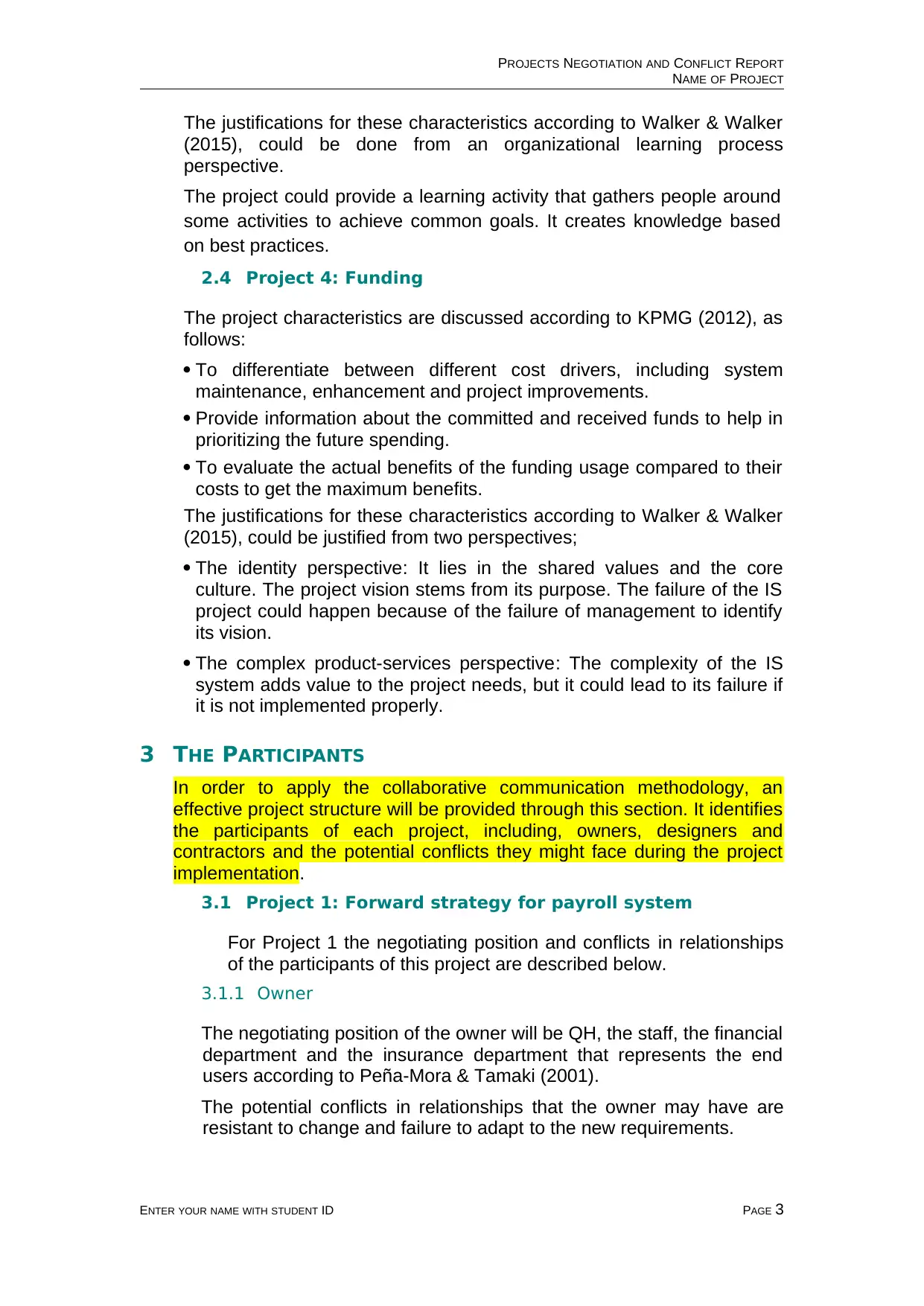
PROJECTS NEGOTIATION AND CONFLICT REPORT
NAME OF PROJECT
The justifications for these characteristics according to Walker & Walker
(2015), could be done from an organizational learning process
perspective.
The project could provide a learning activity that gathers people around
some activities to achieve common goals. It creates knowledge based
on best practices.
2.4 Project 4: Funding
The project characteristics are discussed according to KPMG (2012), as
follows:
To differentiate between different cost drivers, including system
maintenance, enhancement and project improvements.
Provide information about the committed and received funds to help in
prioritizing the future spending.
To evaluate the actual benefits of the funding usage compared to their
costs to get the maximum benefits.
The justifications for these characteristics according to Walker & Walker
(2015), could be justified from two perspectives;
The identity perspective: It lies in the shared values and the core
culture. The project vision stems from its purpose. The failure of the IS
project could happen because of the failure of management to identify
its vision.
The complex product-services perspective: The complexity of the IS
system adds value to the project needs, but it could lead to its failure if
it is not implemented properly.
3 THE PARTICIPANTS
In order to apply the collaborative communication methodology, an
effective project structure will be provided through this section. It identifies
the participants of each project, including, owners, designers and
contractors and the potential conflicts they might face during the project
implementation.
3.1 Project 1: Forward strategy for payroll system
For Project 1 the negotiating position and conflicts in relationships
of the participants of this project are described below.
3.1.1 Owner
The negotiating position of the owner will be QH, the staff, the financial
department and the insurance department that represents the end
users according to Peña-Mora & Tamaki (2001).
The potential conflicts in relationships that the owner may have are
resistant to change and failure to adapt to the new requirements.
ENTER YOUR NAME WITH STUDENT ID PAGE 3
NAME OF PROJECT
The justifications for these characteristics according to Walker & Walker
(2015), could be done from an organizational learning process
perspective.
The project could provide a learning activity that gathers people around
some activities to achieve common goals. It creates knowledge based
on best practices.
2.4 Project 4: Funding
The project characteristics are discussed according to KPMG (2012), as
follows:
To differentiate between different cost drivers, including system
maintenance, enhancement and project improvements.
Provide information about the committed and received funds to help in
prioritizing the future spending.
To evaluate the actual benefits of the funding usage compared to their
costs to get the maximum benefits.
The justifications for these characteristics according to Walker & Walker
(2015), could be justified from two perspectives;
The identity perspective: It lies in the shared values and the core
culture. The project vision stems from its purpose. The failure of the IS
project could happen because of the failure of management to identify
its vision.
The complex product-services perspective: The complexity of the IS
system adds value to the project needs, but it could lead to its failure if
it is not implemented properly.
3 THE PARTICIPANTS
In order to apply the collaborative communication methodology, an
effective project structure will be provided through this section. It identifies
the participants of each project, including, owners, designers and
contractors and the potential conflicts they might face during the project
implementation.
3.1 Project 1: Forward strategy for payroll system
For Project 1 the negotiating position and conflicts in relationships
of the participants of this project are described below.
3.1.1 Owner
The negotiating position of the owner will be QH, the staff, the financial
department and the insurance department that represents the end
users according to Peña-Mora & Tamaki (2001).
The potential conflicts in relationships that the owner may have are
resistant to change and failure to adapt to the new requirements.
ENTER YOUR NAME WITH STUDENT ID PAGE 3
⊘ This is a preview!⊘
Do you want full access?
Subscribe today to unlock all pages.

Trusted by 1+ million students worldwide

PROJECTS NEGOTIATION AND CONFLICT REPORT
NAME OF PROJECT
3.1.2 Designers
The negotiating position of the designers will be IBM as the
responsible company for the IS design.
The potential conflicts in relationships that the designers may have are
represented in the inappropriate way of dealing with the platform and
failure to integrate the system entities into a new complex form.
3.1.3 Contractors
The negotiating position of the contractors will be 'CorpTech', the
responsible unit for managing the payroll and finance implementation
of the projects in the governmental departments.
The potential conflicts in relationships that the contractors may have
are the failure to determine the methods, sequences, techniques and
procedures to direct the project activities (Peña-Mora & Tamaki 2001)
3.2 Project 2: Governance and decision-making
For Project 2 the negotiating position and conflicts in relationships of
the participants of this project are described below.
3.2.1 Owner
The negotiating position of the owner will be the payroll portfolio
steering committee (PPSC) that governs the overall strategic process
and the requirements of the payroll business.
The potential conflicts in relationships that the owner may have are the
failure to define the key payroll elements and inability to ensure
benefits realization.
3.2.2 Designers
The negotiating position of the designers will be IBM.
The potential conflicts in relationships that the designers may have are
the negative impact of the design of systems on the governance
frameworks, cost and transition plans (KPMG 2012).
3.2.3 Contractors
The negotiating position of the contractors will be the payroll portfolio
office. It is responsible for the execution and delivery of the blueprint
of the payroll (KPMG 2012).
The potential conflicts in relationships that the contractors may have is
represented in the failure of execution of the exact needs of the
project.
3.3 Project 3: People and change
For Project 3 the negotiating position and conflicts in relationships of
the participants of this project are described below.
ENTER YOUR NAME WITH STUDENT ID PAGE 4
NAME OF PROJECT
3.1.2 Designers
The negotiating position of the designers will be IBM as the
responsible company for the IS design.
The potential conflicts in relationships that the designers may have are
represented in the inappropriate way of dealing with the platform and
failure to integrate the system entities into a new complex form.
3.1.3 Contractors
The negotiating position of the contractors will be 'CorpTech', the
responsible unit for managing the payroll and finance implementation
of the projects in the governmental departments.
The potential conflicts in relationships that the contractors may have
are the failure to determine the methods, sequences, techniques and
procedures to direct the project activities (Peña-Mora & Tamaki 2001)
3.2 Project 2: Governance and decision-making
For Project 2 the negotiating position and conflicts in relationships of
the participants of this project are described below.
3.2.1 Owner
The negotiating position of the owner will be the payroll portfolio
steering committee (PPSC) that governs the overall strategic process
and the requirements of the payroll business.
The potential conflicts in relationships that the owner may have are the
failure to define the key payroll elements and inability to ensure
benefits realization.
3.2.2 Designers
The negotiating position of the designers will be IBM.
The potential conflicts in relationships that the designers may have are
the negative impact of the design of systems on the governance
frameworks, cost and transition plans (KPMG 2012).
3.2.3 Contractors
The negotiating position of the contractors will be the payroll portfolio
office. It is responsible for the execution and delivery of the blueprint
of the payroll (KPMG 2012).
The potential conflicts in relationships that the contractors may have is
represented in the failure of execution of the exact needs of the
project.
3.3 Project 3: People and change
For Project 3 the negotiating position and conflicts in relationships of
the participants of this project are described below.
ENTER YOUR NAME WITH STUDENT ID PAGE 4
Paraphrase This Document
Need a fresh take? Get an instant paraphrase of this document with our AI Paraphraser
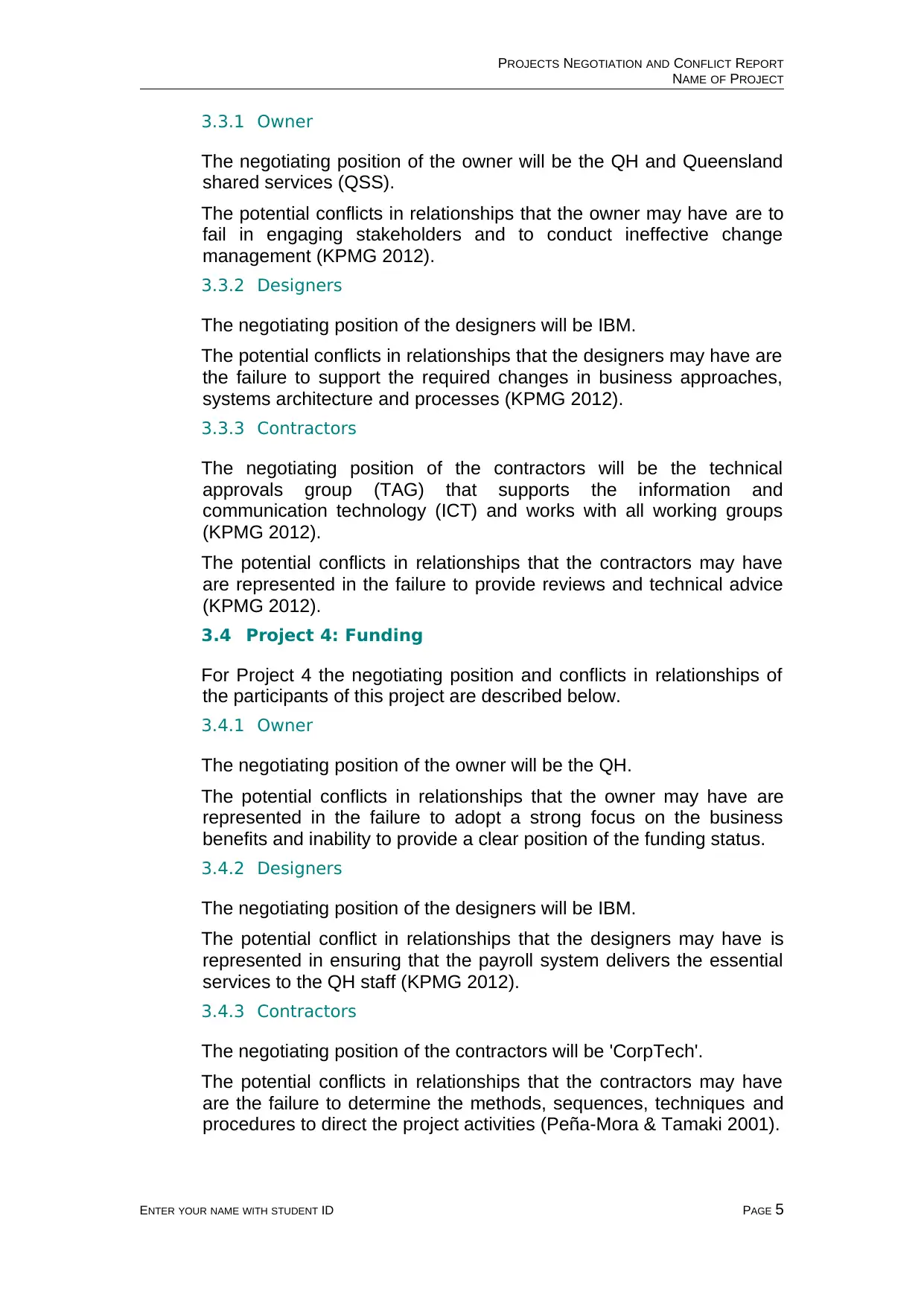
PROJECTS NEGOTIATION AND CONFLICT REPORT
NAME OF PROJECT
3.3.1 Owner
The negotiating position of the owner will be the QH and Queensland
shared services (QSS).
The potential conflicts in relationships that the owner may have are to
fail in engaging stakeholders and to conduct ineffective change
management (KPMG 2012).
3.3.2 Designers
The negotiating position of the designers will be IBM.
The potential conflicts in relationships that the designers may have are
the failure to support the required changes in business approaches,
systems architecture and processes (KPMG 2012).
3.3.3 Contractors
The negotiating position of the contractors will be the technical
approvals group (TAG) that supports the information and
communication technology (ICT) and works with all working groups
(KPMG 2012).
The potential conflicts in relationships that the contractors may have
are represented in the failure to provide reviews and technical advice
(KPMG 2012).
3.4 Project 4: Funding
For Project 4 the negotiating position and conflicts in relationships of
the participants of this project are described below.
3.4.1 Owner
The negotiating position of the owner will be the QH.
The potential conflicts in relationships that the owner may have are
represented in the failure to adopt a strong focus on the business
benefits and inability to provide a clear position of the funding status.
3.4.2 Designers
The negotiating position of the designers will be IBM.
The potential conflict in relationships that the designers may have is
represented in ensuring that the payroll system delivers the essential
services to the QH staff (KPMG 2012).
3.4.3 Contractors
The negotiating position of the contractors will be 'CorpTech'.
The potential conflicts in relationships that the contractors may have
are the failure to determine the methods, sequences, techniques and
procedures to direct the project activities (Peña-Mora & Tamaki 2001).
ENTER YOUR NAME WITH STUDENT ID PAGE 5
NAME OF PROJECT
3.3.1 Owner
The negotiating position of the owner will be the QH and Queensland
shared services (QSS).
The potential conflicts in relationships that the owner may have are to
fail in engaging stakeholders and to conduct ineffective change
management (KPMG 2012).
3.3.2 Designers
The negotiating position of the designers will be IBM.
The potential conflicts in relationships that the designers may have are
the failure to support the required changes in business approaches,
systems architecture and processes (KPMG 2012).
3.3.3 Contractors
The negotiating position of the contractors will be the technical
approvals group (TAG) that supports the information and
communication technology (ICT) and works with all working groups
(KPMG 2012).
The potential conflicts in relationships that the contractors may have
are represented in the failure to provide reviews and technical advice
(KPMG 2012).
3.4 Project 4: Funding
For Project 4 the negotiating position and conflicts in relationships of
the participants of this project are described below.
3.4.1 Owner
The negotiating position of the owner will be the QH.
The potential conflicts in relationships that the owner may have are
represented in the failure to adopt a strong focus on the business
benefits and inability to provide a clear position of the funding status.
3.4.2 Designers
The negotiating position of the designers will be IBM.
The potential conflict in relationships that the designers may have is
represented in ensuring that the payroll system delivers the essential
services to the QH staff (KPMG 2012).
3.4.3 Contractors
The negotiating position of the contractors will be 'CorpTech'.
The potential conflicts in relationships that the contractors may have
are the failure to determine the methods, sequences, techniques and
procedures to direct the project activities (Peña-Mora & Tamaki 2001).
ENTER YOUR NAME WITH STUDENT ID PAGE 5
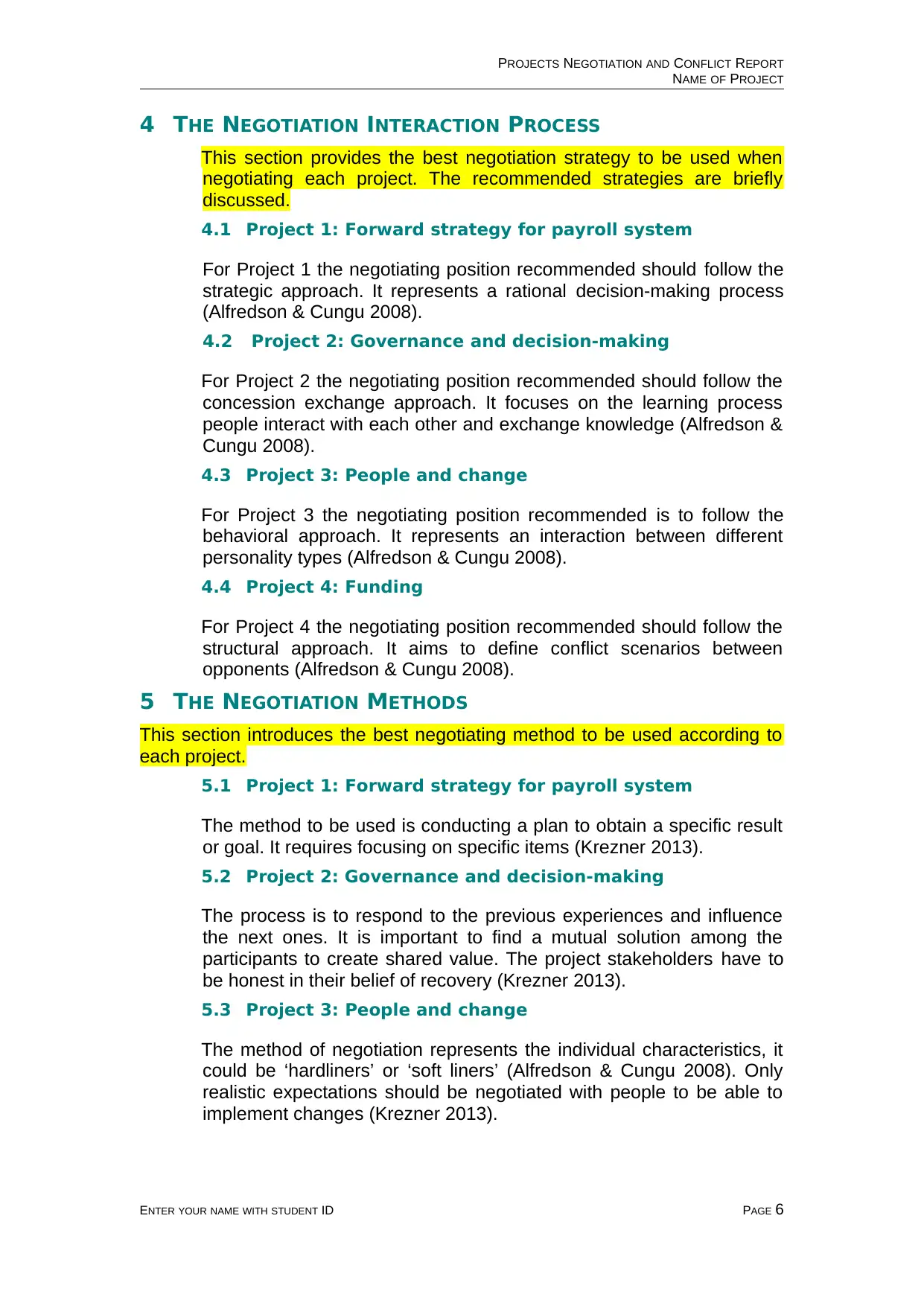
PROJECTS NEGOTIATION AND CONFLICT REPORT
NAME OF PROJECT
4 THE NEGOTIATION INTERACTION PROCESS
This section provides the best negotiation strategy to be used when
negotiating each project. The recommended strategies are briefly
discussed.
4.1 Project 1: Forward strategy for payroll system
For Project 1 the negotiating position recommended should follow the
strategic approach. It represents a rational decision-making process
(Alfredson & Cungu 2008).
4.2 Project 2: Governance and decision-making
For Project 2 the negotiating position recommended should follow the
concession exchange approach. It focuses on the learning process
people interact with each other and exchange knowledge (Alfredson &
Cungu 2008).
4.3 Project 3: People and change
For Project 3 the negotiating position recommended is to follow the
behavioral approach. It represents an interaction between different
personality types (Alfredson & Cungu 2008).
4.4 Project 4: Funding
For Project 4 the negotiating position recommended should follow the
structural approach. It aims to define conflict scenarios between
opponents (Alfredson & Cungu 2008).
5 THE NEGOTIATION METHODS
This section introduces the best negotiating method to be used according to
each project.
5.1 Project 1: Forward strategy for payroll system
The method to be used is conducting a plan to obtain a specific result
or goal. It requires focusing on specific items (Krezner 2013).
5.2 Project 2: Governance and decision-making
The process is to respond to the previous experiences and influence
the next ones. It is important to find a mutual solution among the
participants to create shared value. The project stakeholders have to
be honest in their belief of recovery (Krezner 2013).
5.3 Project 3: People and change
The method of negotiation represents the individual characteristics, it
could be ‘hardliners’ or ‘soft liners’ (Alfredson & Cungu 2008). Only
realistic expectations should be negotiated with people to be able to
implement changes (Krezner 2013).
ENTER YOUR NAME WITH STUDENT ID PAGE 6
NAME OF PROJECT
4 THE NEGOTIATION INTERACTION PROCESS
This section provides the best negotiation strategy to be used when
negotiating each project. The recommended strategies are briefly
discussed.
4.1 Project 1: Forward strategy for payroll system
For Project 1 the negotiating position recommended should follow the
strategic approach. It represents a rational decision-making process
(Alfredson & Cungu 2008).
4.2 Project 2: Governance and decision-making
For Project 2 the negotiating position recommended should follow the
concession exchange approach. It focuses on the learning process
people interact with each other and exchange knowledge (Alfredson &
Cungu 2008).
4.3 Project 3: People and change
For Project 3 the negotiating position recommended is to follow the
behavioral approach. It represents an interaction between different
personality types (Alfredson & Cungu 2008).
4.4 Project 4: Funding
For Project 4 the negotiating position recommended should follow the
structural approach. It aims to define conflict scenarios between
opponents (Alfredson & Cungu 2008).
5 THE NEGOTIATION METHODS
This section introduces the best negotiating method to be used according to
each project.
5.1 Project 1: Forward strategy for payroll system
The method to be used is conducting a plan to obtain a specific result
or goal. It requires focusing on specific items (Krezner 2013).
5.2 Project 2: Governance and decision-making
The process is to respond to the previous experiences and influence
the next ones. It is important to find a mutual solution among the
participants to create shared value. The project stakeholders have to
be honest in their belief of recovery (Krezner 2013).
5.3 Project 3: People and change
The method of negotiation represents the individual characteristics, it
could be ‘hardliners’ or ‘soft liners’ (Alfredson & Cungu 2008). Only
realistic expectations should be negotiated with people to be able to
implement changes (Krezner 2013).
ENTER YOUR NAME WITH STUDENT ID PAGE 6
⊘ This is a preview!⊘
Do you want full access?
Subscribe today to unlock all pages.

Trusted by 1+ million students worldwide
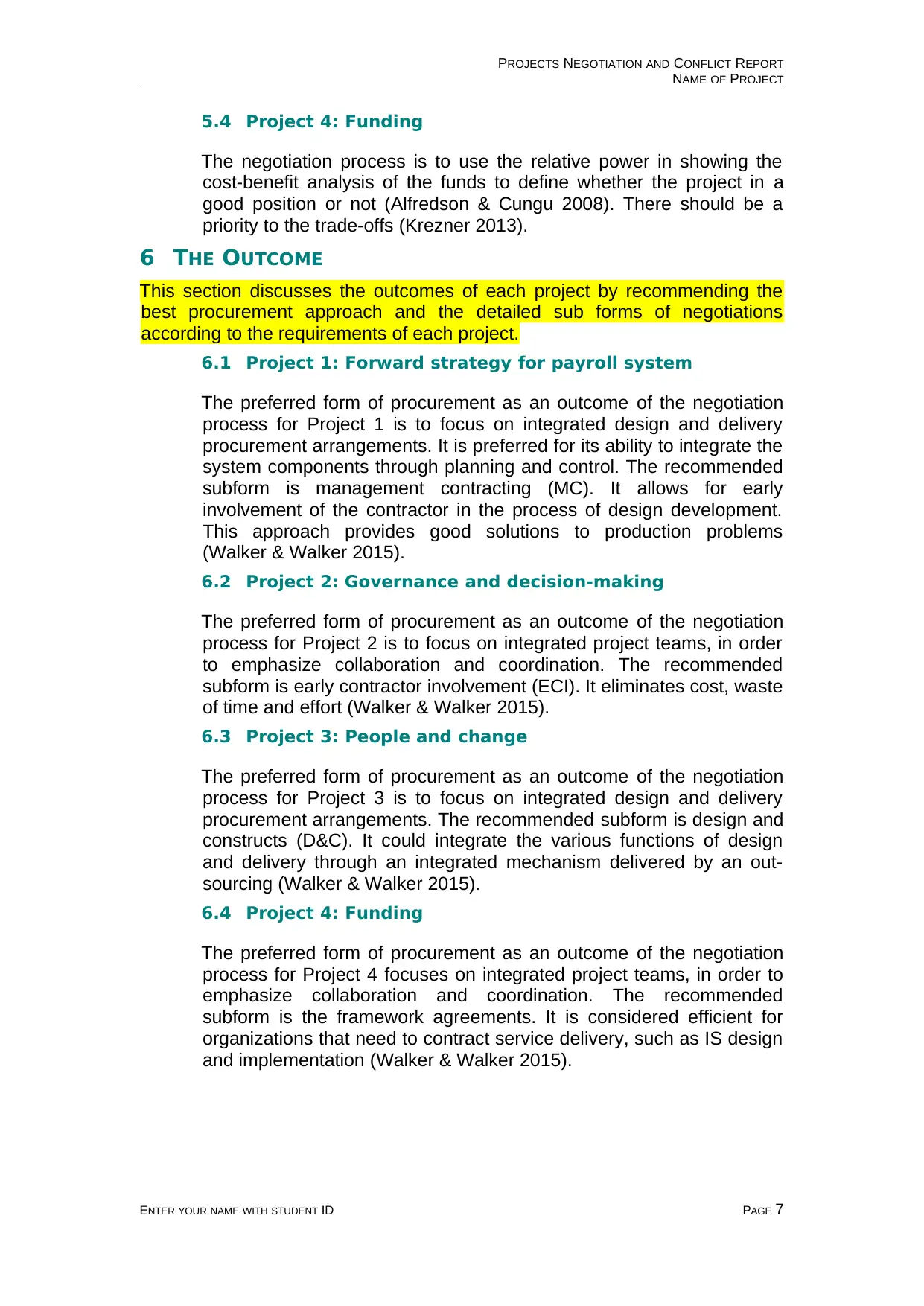
PROJECTS NEGOTIATION AND CONFLICT REPORT
NAME OF PROJECT
5.4 Project 4: Funding
The negotiation process is to use the relative power in showing the
cost-benefit analysis of the funds to define whether the project in a
good position or not (Alfredson & Cungu 2008). There should be a
priority to the trade-offs (Krezner 2013).
6 THE OUTCOME
This section discusses the outcomes of each project by recommending the
best procurement approach and the detailed sub forms of negotiations
according to the requirements of each project.
6.1 Project 1: Forward strategy for payroll system
The preferred form of procurement as an outcome of the negotiation
process for Project 1 is to focus on integrated design and delivery
procurement arrangements. It is preferred for its ability to integrate the
system components through planning and control. The recommended
subform is management contracting (MC). It allows for early
involvement of the contractor in the process of design development.
This approach provides good solutions to production problems
(Walker & Walker 2015).
6.2 Project 2: Governance and decision-making
The preferred form of procurement as an outcome of the negotiation
process for Project 2 is to focus on integrated project teams, in order
to emphasize collaboration and coordination. The recommended
subform is early contractor involvement (ECI). It eliminates cost, waste
of time and effort (Walker & Walker 2015).
6.3 Project 3: People and change
The preferred form of procurement as an outcome of the negotiation
process for Project 3 is to focus on integrated design and delivery
procurement arrangements. The recommended subform is design and
constructs (D&C). It could integrate the various functions of design
and delivery through an integrated mechanism delivered by an out-
sourcing (Walker & Walker 2015).
6.4 Project 4: Funding
The preferred form of procurement as an outcome of the negotiation
process for Project 4 focuses on integrated project teams, in order to
emphasize collaboration and coordination. The recommended
subform is the framework agreements. It is considered efficient for
organizations that need to contract service delivery, such as IS design
and implementation (Walker & Walker 2015).
ENTER YOUR NAME WITH STUDENT ID PAGE 7
NAME OF PROJECT
5.4 Project 4: Funding
The negotiation process is to use the relative power in showing the
cost-benefit analysis of the funds to define whether the project in a
good position or not (Alfredson & Cungu 2008). There should be a
priority to the trade-offs (Krezner 2013).
6 THE OUTCOME
This section discusses the outcomes of each project by recommending the
best procurement approach and the detailed sub forms of negotiations
according to the requirements of each project.
6.1 Project 1: Forward strategy for payroll system
The preferred form of procurement as an outcome of the negotiation
process for Project 1 is to focus on integrated design and delivery
procurement arrangements. It is preferred for its ability to integrate the
system components through planning and control. The recommended
subform is management contracting (MC). It allows for early
involvement of the contractor in the process of design development.
This approach provides good solutions to production problems
(Walker & Walker 2015).
6.2 Project 2: Governance and decision-making
The preferred form of procurement as an outcome of the negotiation
process for Project 2 is to focus on integrated project teams, in order
to emphasize collaboration and coordination. The recommended
subform is early contractor involvement (ECI). It eliminates cost, waste
of time and effort (Walker & Walker 2015).
6.3 Project 3: People and change
The preferred form of procurement as an outcome of the negotiation
process for Project 3 is to focus on integrated design and delivery
procurement arrangements. The recommended subform is design and
constructs (D&C). It could integrate the various functions of design
and delivery through an integrated mechanism delivered by an out-
sourcing (Walker & Walker 2015).
6.4 Project 4: Funding
The preferred form of procurement as an outcome of the negotiation
process for Project 4 focuses on integrated project teams, in order to
emphasize collaboration and coordination. The recommended
subform is the framework agreements. It is considered efficient for
organizations that need to contract service delivery, such as IS design
and implementation (Walker & Walker 2015).
ENTER YOUR NAME WITH STUDENT ID PAGE 7
Paraphrase This Document
Need a fresh take? Get an instant paraphrase of this document with our AI Paraphraser
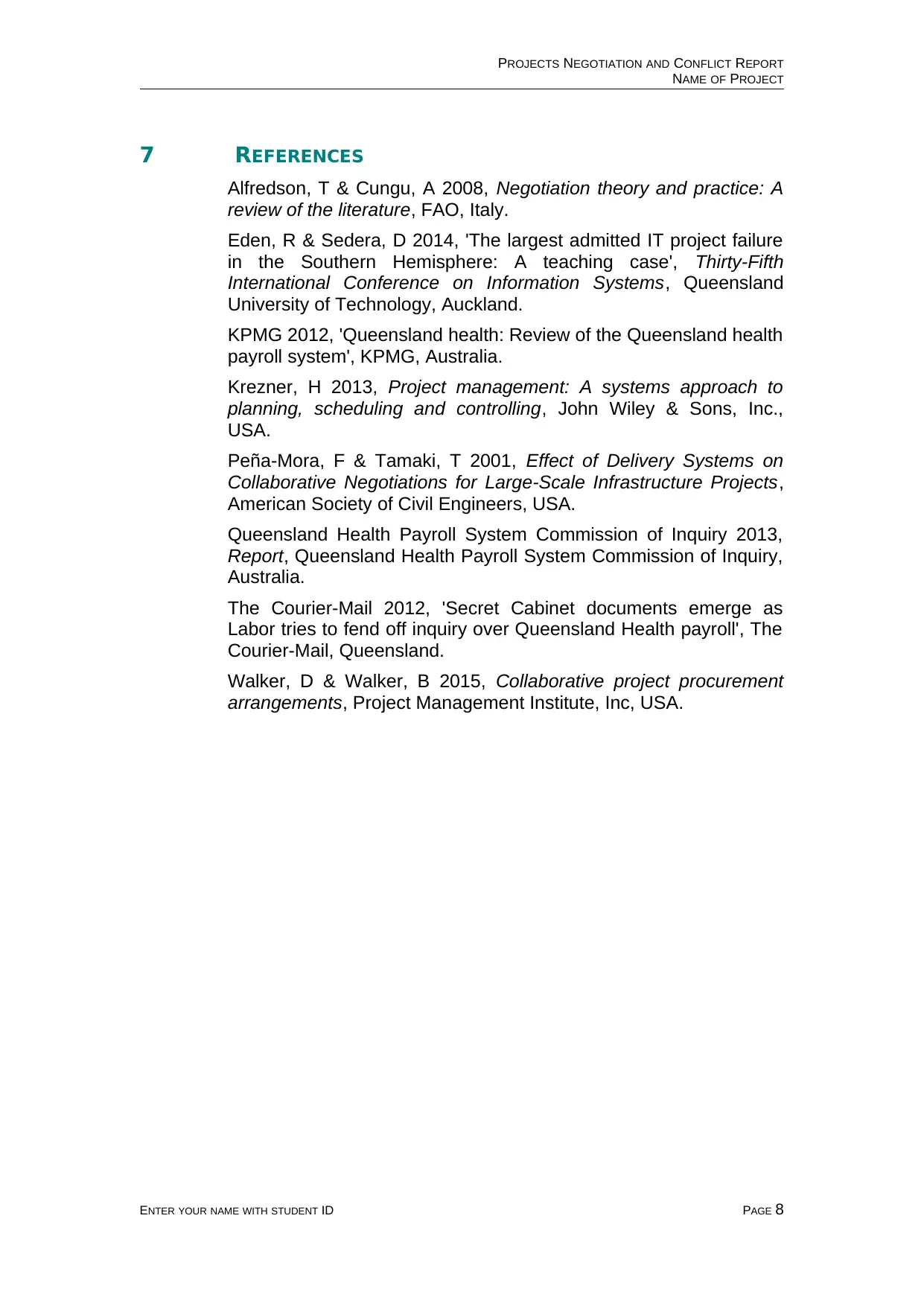
PROJECTS NEGOTIATION AND CONFLICT REPORT
NAME OF PROJECT
7 REFERENCES
Alfredson, T & Cungu, A 2008, Negotiation theory and practice: A
review of the literature, FAO, Italy.
Eden, R & Sedera, D 2014, 'The largest admitted IT project failure
in the Southern Hemisphere: A teaching case', Thirty-Fifth
International Conference on Information Systems, Queensland
University of Technology, Auckland.
KPMG 2012, 'Queensland health: Review of the Queensland health
payroll system', KPMG, Australia.
Krezner, H 2013, Project management: A systems approach to
planning, scheduling and controlling, John Wiley & Sons, Inc.,
USA.
Peña-Mora, F & Tamaki, T 2001, Effect of Delivery Systems on
Collaborative Negotiations for Large-Scale Infrastructure Projects,
American Society of Civil Engineers, USA.
Queensland Health Payroll System Commission of Inquiry 2013,
Report, Queensland Health Payroll System Commission of Inquiry,
Australia.
The Courier-Mail 2012, 'Secret Cabinet documents emerge as
Labor tries to fend off inquiry over Queensland Health payroll', The
Courier-Mail, Queensland.
Walker, D & Walker, B 2015, Collaborative project procurement
arrangements, Project Management Institute, Inc, USA.
ENTER YOUR NAME WITH STUDENT ID PAGE 8
NAME OF PROJECT
7 REFERENCES
Alfredson, T & Cungu, A 2008, Negotiation theory and practice: A
review of the literature, FAO, Italy.
Eden, R & Sedera, D 2014, 'The largest admitted IT project failure
in the Southern Hemisphere: A teaching case', Thirty-Fifth
International Conference on Information Systems, Queensland
University of Technology, Auckland.
KPMG 2012, 'Queensland health: Review of the Queensland health
payroll system', KPMG, Australia.
Krezner, H 2013, Project management: A systems approach to
planning, scheduling and controlling, John Wiley & Sons, Inc.,
USA.
Peña-Mora, F & Tamaki, T 2001, Effect of Delivery Systems on
Collaborative Negotiations for Large-Scale Infrastructure Projects,
American Society of Civil Engineers, USA.
Queensland Health Payroll System Commission of Inquiry 2013,
Report, Queensland Health Payroll System Commission of Inquiry,
Australia.
The Courier-Mail 2012, 'Secret Cabinet documents emerge as
Labor tries to fend off inquiry over Queensland Health payroll', The
Courier-Mail, Queensland.
Walker, D & Walker, B 2015, Collaborative project procurement
arrangements, Project Management Institute, Inc, USA.
ENTER YOUR NAME WITH STUDENT ID PAGE 8
1 out of 8
Related Documents
Your All-in-One AI-Powered Toolkit for Academic Success.
+13062052269
info@desklib.com
Available 24*7 on WhatsApp / Email
![[object Object]](/_next/static/media/star-bottom.7253800d.svg)
Unlock your academic potential
Copyright © 2020–2025 A2Z Services. All Rights Reserved. Developed and managed by ZUCOL.



